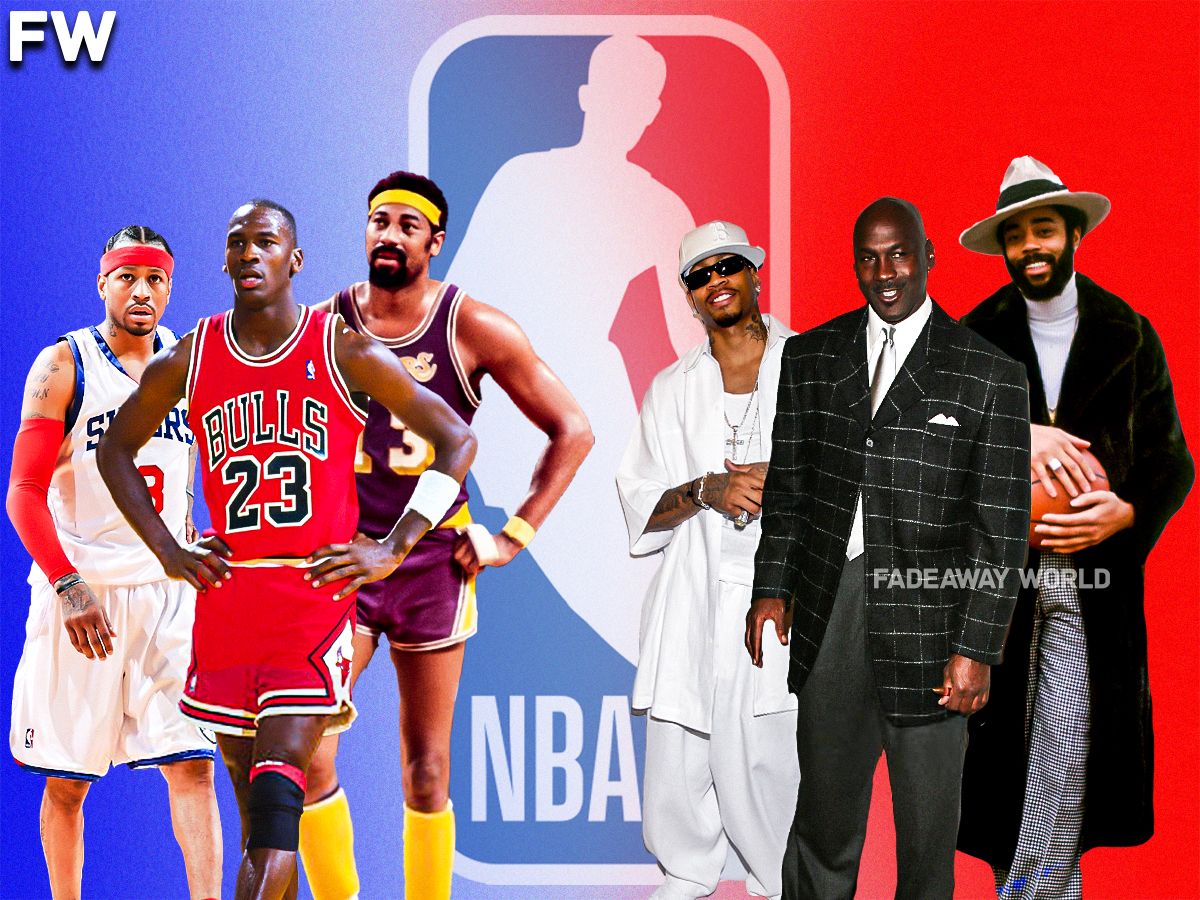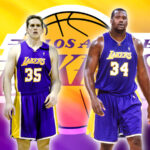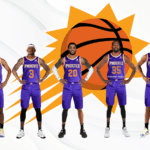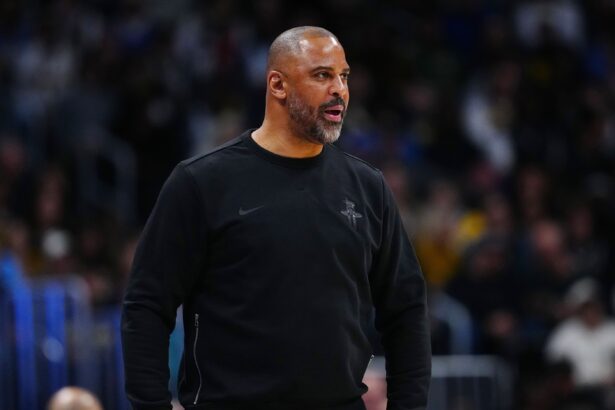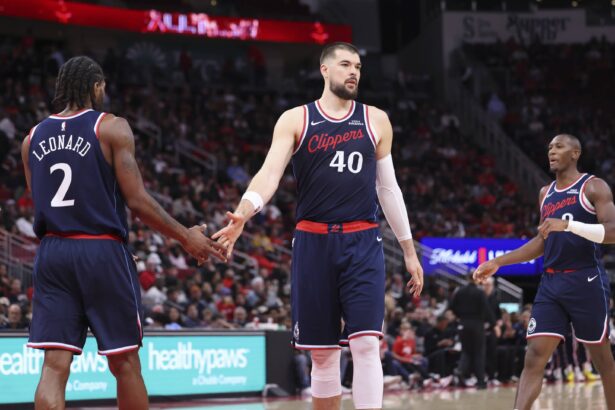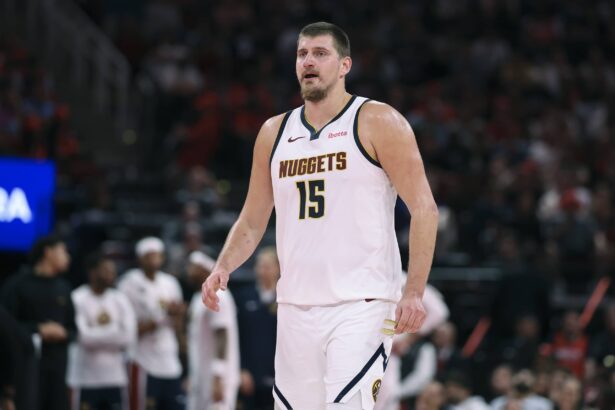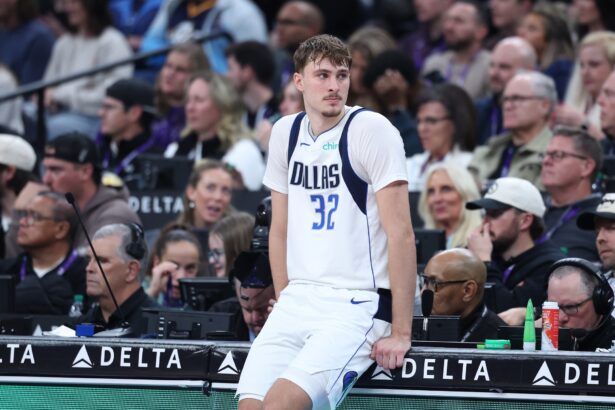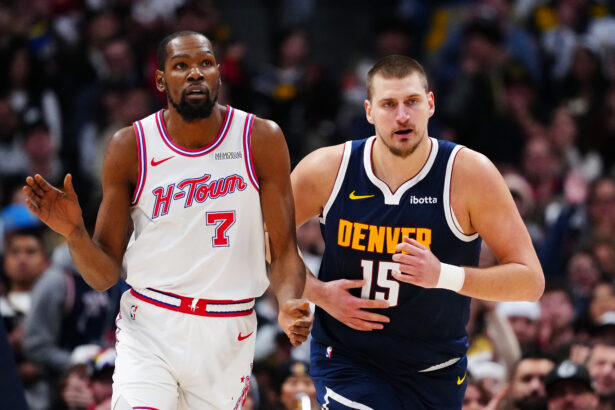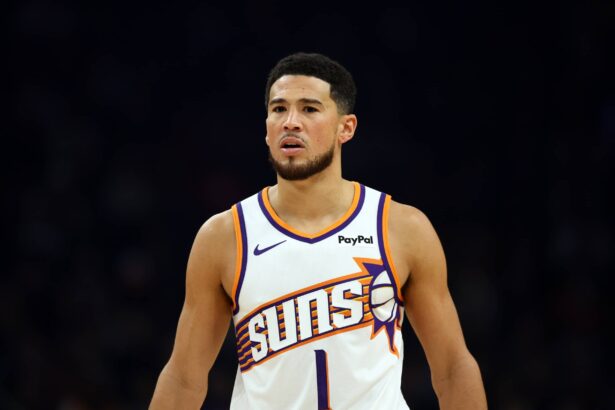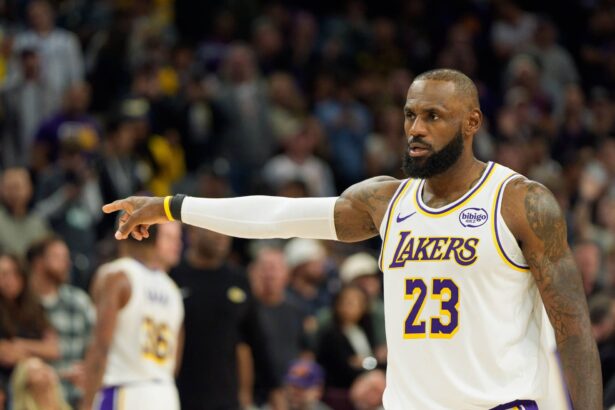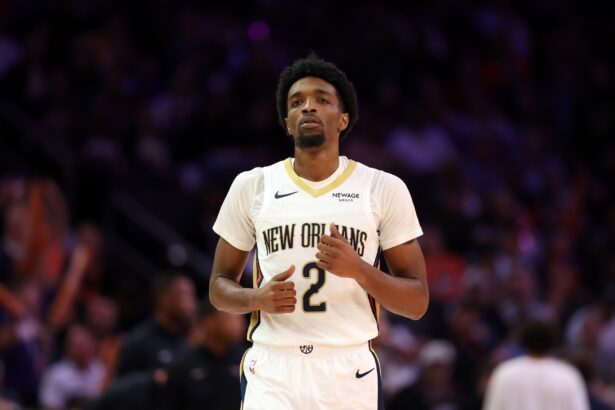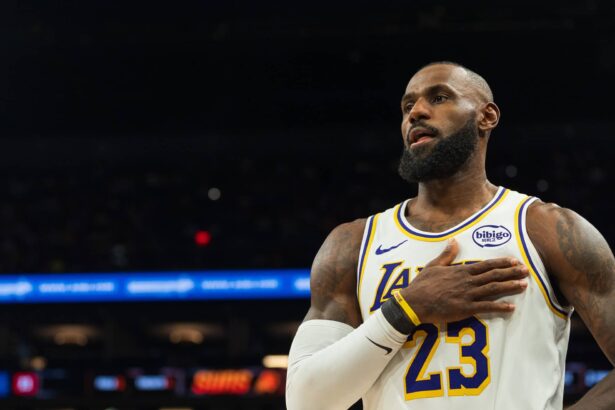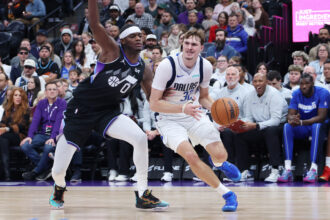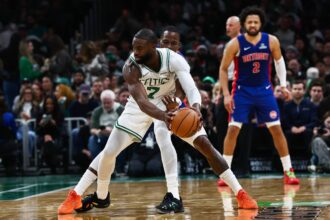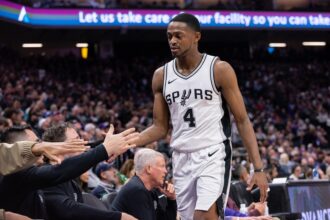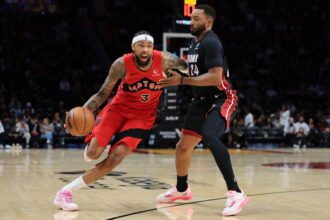- Button-up suits were the off-court style when the NBA was founded
- Players wore very short shorts up to the mid-1980s
- The NBA enforced a dress code in 2005
The NBA has always been at the forefront of fashion and style. From the striped tube socks of the 70s to the “Fab Five” of the early 90s, the league has set trends and pushed boundaries when it comes to the fashion industry.
The evolution of NBA fashion has been a fascinating journey to watch, as players have gone from wearing short shorts and high socks to bold, statement outfits that showcase their individuality and creativity.
In this article, we will take a look at the history of NBA fashion, the trends that have emerged over the years, and the impact that it has had on the fashion industry as a whole.
On-Court Attire

We will begin by discussing the on-court attire of the players. When the NBA began back in the late 1940s, what the players wore was a little different than the uniforms of today.
For starters, the uniforms were basic shorts and tank tops. The shorts were also worn very short, while the socks were high and usually striped.
The players from the 40s and 50s didn’t care that much about how they looked on the court. Their focus was on winning basketball games. Of course, this would change, as players wanted to win and look good while doing it.
In the 1960s, America was starting to change. African Americans were fighting for their civil rights, and the NBA started to look more diverse.
After players like Chuck Cooper, Nat Clifton, and Earl Lloyd broke the NBA’s color barrier in the 1950s, the league still struggled to see African American players. By the 1960s, not only did the league have a lot more nonwhite players, but African American players were finally allowed to be stars on their teams.
This was led by NBA greats Bill Russell and Wilt Chamberlain. Not only were they stars in the league, but to this day, Russell and Chamberlain are among the biggest we’ve ever seen.
For Russell, it was his dominance on the court that made him popular. Russell’s 11 championships are still the most won by a player. As for Chamberlain, his incredible scoring prowess, like dropping 100 points in a single game, made him larger than life.
It was Chamberlain who would make fashion history on the basketball court. Chamberlain is credited as the first player in NBA history to wear a headband while playing.
Wilt Chamberlain's headband from 1971 is being sold in SCP Auction's sale in August. Estimate is $4,000 to $6,000 pic.twitter.com/j9A9E77SFW
— Darren Rovell (@darrenrovell) June 27, 2016
For Chamberlain, it wasn’t a fashion statement. The Big Dipper’s reasoning for wearing a headband was quite simple. He wanted to keep the sweat out of his eyes.
Over the course of time, NBA players would wear headbands for other reasons, like personal style. Some even wore headbands to cover up their receding hairline… Sorry, LeBron James.
Another player, Donald Earl Watts, who played for six seasons, mostly for the Seattle SuperSonics, is also credited as one of the first to wear a headband. Now, for Watts, his reasoning behind wearing the headband just as well may have been to add some style to the league.
Watts’ nickname was Slick, and slick he certainly was. One unique thing about Watts’ headband was how he wore it. Watts always wore his headband off-center, giving him a distinctive look.
Even to this day, you’ll likely find Watts wearing a headband, even though he retired from the NBA after the 1978-79 season. Headbands are not the only basketball accessory players have turned into fashion statements.
A wristband is a common accessory players will wear. This is a good tool to use to wipe the sweat out of your eyes if need be.
But in the 1980s, a certain high-flying, tongue-wagging player added some flare to his wristband. Yes, I am speaking about the G.O.A.T., Michael Jordan.
Jordan famously wore his wristband up around his elbow and sometimes up to his biceps. Now, the reason for Jordan’s positioning of his wristband actually wasn’t meant to be a fashion statement. No, the real reason was a lot more wholesome.
Jordan first wore his wristband up to his elbow as a sophomore at North Carolina University. The reason for this was Jordan wanted to honor his friend and teammate, Buzz Peterson, who injured his knee that year.
Jordan also turned your everyday basketball shoe into a fashion statement and business model for all professional athletes. MJ’s ‘Air Jordan’ shoe line from Nike became so popular that every year, fans and other NBA players alike couldn’t wait to see what the new model of shoe looked like.
This led to other NBA players getting their own shoe lines, and it has made the athletes, as well as the shoe companies, mighty wealthy. It seemed that no matter what Jordan did, people tried to copy him.
That’s how huge MJ was in his prime. Another fashion trend Jordan started was wearing longer shorts.
The players’ shorts were famously very short and this was the norm until the 80s. Jordan started to wear shorts down just above his knees. There are two reported reasons for why MJ made the change in the length of his shorts.
The first reason is Jordan liked to wear his UNC shorts under his Chicago Bulls shorts. MJ believed his college shorts gave him good luck, and he wanted to hide them, so he wore longer Bulls shorts.
The second believed reason is Jordan liked to tug on his shorts while playing defense. It made it easier for Jordan to tug on his shorts when they were longer.
The length of basketball shorts continued to grow to incredible lengths in the 1990s, thanks to a group of college basketball stars. It was 1991, and the University of Michigan had five star players who were known as the Fab Five.
This group was made up of players Juwan Howard, Jalen Rose, Chris Webber, Jimmy King, and Ray Jackson. These players wore their shorts past their knees, and they were extremely baggy.
This look shocked most fans, as the 80s short shorts were truly out of fashion. The NBA as a league didn’t particularly like this trend, which most players not named John Stockton adapted to.
In 1997, the NBA put in a new rule stating players’ shorts were required to be at least one inch above the knee. If a player wore longer shorts, they would be subject to a fine.
The style would continue to change when Allen Iverson hit the scene. This includes on and off the court. For his one-the-court style, Iverson made fashion history on January 21, 2001, when he wore the first-ever shooting sleeve.
Again, like most accessories in the past, Iverson was not wearing it initially as a fashion statement. Iverson suffered bursitis in his shooting elbow, and this was why he wore the sleeve.
Fans and NBA players alike loved the look, and players all over the league adopted the look. Leg sleeves also started showing up, and it’s credited to Jerry Stackhouse.
Stackhouse was a vocal supporter of leg sleeves and often spoke about the health benefits of wearing the tights. Like other accessories, many other players followed suit by wearing them, likely for style.
The on-court fashion has continued to change up to the current day. This includes players wearing any color show they choose, something they couldn’t do until the 2018-19 season.
Players and the league have also used their on-court fashion to make a statement about change. This includes wearing warm-up shirts that say “Black Lives Matter”, among other social and ethical statements.
This is something the NBA would have never allowed, even as late as the 1990s. Change can be good, and the style of NBA players is no stranger to that. This includes the players’ off-court attire.
Off-Court Attire

When it comes to being a professional basketball player, being fashionable off the court is equally as important as on the court. When the league first started, players dressed modestly off the court.
Players wore button-up suits. This was the norm for any man during this time period. But as mentioned earlier, when African Americans were finally allowed to be stars, they also changed the fashion game.
This included Bill Russell, who often liked to have his blazer unbuttoned. It’s a small but different take on how most players wore their suits at the time.
When the 1970s rolled around, fashion off the court really changed. Wilt Chamberlain liked to wear unbuttoned shirts, showing off his enormous chest. This includes wearing a nice shiny necklace for all to see.
The disco era of the 70s had a major impact on how players chose their attire. This includes wearing their hair out in a large afro, like Julius Dr. J Erving.
The players also wore bright color shirts and plaid suits. If there was one player who led the charge in fashion off the court during the 1970s, it was Walt Frazier.
Frazier wore mink coats and wide-brimmed fedoras while rocking muttonchops sideburns. Yes, Frazier was the definition of cool.
The biggest draw to Frazier’s style was his choice of suits. Frazier went bolder than the plaid suits of the time with colorful suits that often had unique prints on them, like flowers.
Over time, suits became baggier, like in the 1990s. You couldn’t turn on a post-game interview without seeing Michael Jordan in an extra-large suit.
The biggest change in style would come from Allen Iverson, who single-handedly ushered in the hip-hop era to NBA life. Yes, Iverson rocked baggy sweat suits with large gold chains while wearing his hair in cornrows, which were often covered by a durag.
To top it off, Iverson became covered in tattoos, something we didn’t see a lot of on basketball players. It was Iverson’s style that helped to bring in a brand new audience to the game of basketball, as he was very relatable in ways even Michael Jordan wasn’t.
You’d think the NBA would be ecstatic to have a star player who brought in new fans. This was not the case, though.
Commissioner David Stern had it out for Iverson. He despised the hip-hop culture and hated the way Iverson and the other players dressed.
This led to Stern putting in a dress code, as he tried to eliminate players wearing “street clothes”. Stern’s dress code forced players to wear business casual attire to press conferences and if they were sitting on the bench, if not playing.
Here is the list of attire and accessories banned by Commissioner David Stern:
(H/T Ballislife)
- Sleeveless shirts
- Shorts
- T-shirts, jerseys, or sports apparel (unless appropriate for the event (e.g., a basketball clinic), team-identified, and approved by the team)
- Headgear of any kind while a player is sitting on the bench or in the stands at a game, during media interviews, or during a team or league event or appearance (unless appropriate for the event or appearance, team-identified, and approved by the team)
- Chains, pendants, or medallions worn over the player’s clothes
- Sunglasses while indoors
- Headphones (other than on the team bus or plane or in the team locker room)
Of course, Iverson and other NBA stars disagreed with Stern’s new clothing rule. The dress code, even though it relaxed throughout the years, was officially dropped in the 2019-20 season.
Today, NBA stars wear basically whatever they want. Some wear very fashionable attire, like Russell Westbrook. The fashion world and the NBA have unofficially merged in today’s world.
You’ll often see players at huge fashion events. This includes the time Westbrook appeared in the Thom Browne Fashion Show wearing a kilt skirt and leather boots.
Yes, fashion has changed, and the players are allowed to express themselves much more freely today than they ever had before. This is certainly a good thing.
The NBA is a business, yes, but if the players who make the league what it is can’t express themselves, it can cause problems. It’s a smart decision by the NBA to allow players the option to wear fashionable attire.
The league itself has even jumped on the chance to continue and enhance and somewhat exploit fashion. Every season recently, teams have come out with different-style jerseys.
This includes a new City Edition jersey each year. The NBA has capitalized on the fans and their hunger to buy the new City Edition jersey each and every year.
2023-24 NBA City Edition Jerseys pic.twitter.com/kkgrUKWqoj
— NBACentral (@TheDunkCentral) October 23, 2023
Some fans believe a new City Edition jersey each year is a bit much. Others bite their nails in anticipation of what their favorite team’s new thread will look like.
As the years continue to go by, it will be exciting to see how fashion in the NBA, on and off the court, will continue to evolve. Will the outfits become more outlandish? Or will they mellow out to the style of the past?
We sincerely appreciate and respect you as a reader of our site. It would help us a lot if you follow us on Google News because of the latest update.
Thanks for following us. We really appreciate your support.

